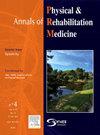Cardiac rehabilitation and physical activity decrease the risk of stroke after acute myocardial infarction: A nationwide cohort study in Sweden
IF 4.6
3区 医学
Q1 REHABILITATION
Annals of Physical and Rehabilitation Medicine
Pub Date : 2025-04-19
DOI:10.1016/j.rehab.2025.101971
引用次数: 0
Abstract
Background
Stroke and acute myocardial infarction (AMI) rank among the leading causes of mortality. Physical activity and exercise are recommended as part of rehabilitation after AMI to prevent cardiovascular events, but the importance for stroke prevention has not been investigated using population-based data.
Objectives
To determine associations between participation in exercise-based cardiac rehabilitation (EBCR) and self-reported physical activity with the risk of total stroke, ischemic stroke, and intracerebral hemorrhage after AMI.
Methods
This was a nationwide, double cohort study conducted across all coronary care units in Sweden between 2005 and 2020, combined with registered data from the general population. Participation in EBCR (24 physiotherapist-led sessions over 4 months) and self-reported physical activity were assessed at a median of 55 days (range 28–90) after hospital discharge. Stroke incidence was followed until death or censoring on December 31, 2021.
Results
A total of 86,637 people with AMI (mean age 64.0, SD 9.0 years; 26 % female), and 259,911 (1:3) age, sex, and region of birth matched individuals from the general population were included. Participation in EBCR after AMI was associated with a lower risk of total stroke (adjusted hazard ratio, aHR 0.85; 95 % confidence interval, CI 0.80–0.91) compared to non-participants, as was ≥150 min of physical activity per week (aHR 0.79, 95 % CI 0.75–0.83). Those reporting physical activity 6 days per week after AMI did not have an increased risk of total stroke or ischemic stroke compared to the general population (aHR 1.03, 95 % CI 0.87–1.23; and aHR 1.17, 95 % CI 0.97–1.41), and were at lower risk of intracerebral hemorrhage (aHR 0.59, 95 % CI 0.35–0.98).
Conclusions
EBCR and higher levels of physical activity are associated with a decreased risk of stroke after AMI. Cardiac rehabilitation programs and regular and physical activity should be promoted after AMI to decrease the burden of stroke. Swedish Ethical Review Authority Registration number: 2021–03645.
心脏康复和身体活动降低急性心肌梗死后中风的风险:瑞典的一项全国性队列研究
背景:中风和急性心肌梗死(AMI)是导致死亡的主要原因。体育活动和锻炼被推荐作为AMI后康复的一部分,以预防心血管事件,但对卒中预防的重要性尚未使用基于人群的数据进行调查。目的:确定参与基于运动的心脏康复(EBCR)和自我报告的身体活动与AMI后总卒中、缺血性卒中和脑出血风险之间的关系。方法:这是一项全国性的双队列研究,在2005年至2020年期间在瑞典所有冠状动脉护理单位进行,并结合了普通人群的登记数据。在出院后55天(范围28-90天)对参与EBCR(24次物理治疗师主导的4个月疗程)和自我报告的身体活动进行评估。跟踪中风发病率,直到2021年12月31日死亡或审查。结果共86637例AMI患者(平均年龄64.0岁,SD 9.0岁;包括259,911(1:3)年龄、性别和出生地区与一般人群相匹配的个体。AMI后参加EBCR与总卒中风险较低相关(校正风险比,aHR 0.85;95%可信区间,CI 0.80-0.91),每周体力活动≥150分钟(aHR 0.79, 95% CI 0.75-0.83)。与一般人群相比,AMI后每周运动6天的患者发生总卒中或缺血性卒中的风险没有增加(aHR 1.03, 95% CI 0.87-1.23;aHR为1.17,95% CI 0.97-1.41),脑出血风险较低(aHR 0.59, 95% CI 0.35-0.98)。结论sebcr和高水平的身体活动与AMI后卒中风险降低相关。AMI后应提倡心脏康复计划和定期体育活动,以减少卒中的负担。瑞典伦理审查机构注册号:2021-03645。
本文章由计算机程序翻译,如有差异,请以英文原文为准。
求助全文
约1分钟内获得全文
求助全文
来源期刊

Annals of Physical and Rehabilitation Medicine
Medicine-Rehabilitation
CiteScore
7.80
自引率
4.30%
发文量
136
审稿时长
34 days
期刊介绍:
Annals of Physical and Rehabilitation Medicine covers all areas of Rehabilitation and Physical Medicine; such as: methods of evaluation of motor, sensory, cognitive and visceral impairments; acute and chronic musculoskeletal disorders and pain; disabilities in adult and children ; processes of rehabilitation in orthopaedic, rhumatological, neurological, cardiovascular, pulmonary and urological diseases.
 求助内容:
求助内容: 应助结果提醒方式:
应助结果提醒方式:


